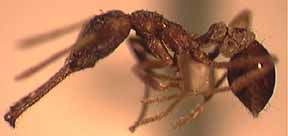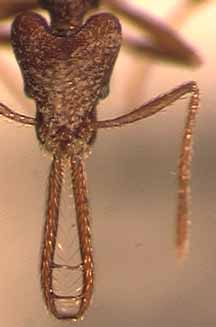Strumigenys cordovensis Mayr 1887
Strumigenys deletrix Bolton ms
Dacetini, Myrmicinae, Formicidae, Hymenoptera, Insecta, Arthropoda, Animalia
John T. Longino, The Evergreen State College, Olympia WA 98505
USA. longinoj@evergreen.edu
24 July 1997

Specimen: Costa Rica, Prov. Puntarenas: 19km S. Ciudad Neily, 20m (J. Longino 2658-s). INBIOCRI001281636. Image by J. Longino.
|

Specimen: Costa Rica, Prov. Puntarenas: 19km S. Ciudad Neily, 20m (J. Longino 2658-s). INBIOCRI001281636. Image by J. Longino. |
Note: This page is based on a set of Costa Rican specimens I had determined as S. cordovensis and sent to Bolton for verification. He separated one collection (from 19km S Ciudad Neily) as a distinct species, S. deletrix Bolton ms. The images on this page are from that collection. I do not know the differences between cordovensis and deletrix, and await additional information from Bolton.
Identification
Apical fork of mandible with a single intercalary tooth; mandible with two conspicuous preapical teeth; mandible extremely long, longer than head; gaster smooth and shiny.
Head length 0.73-0.82mm, mandible length 0.83-0.92, CI 76-80, MI 109-123 (n=40 workers from 8 localities; Brown 1962).
Range
Southern Mexico to Trinidad and Guianas. Costa Rica: both slopes to 500m.
Natural History
Brown and Wilson (1959) summarize the genus as follows:
"Widespread in tropics and warm temperate areas. Primarily forest-dwelling; some species occur in grassland and arid scrub. ... Nests mostly in soil and rotting wood; a few species live in arboreal plant cavities in tropical rain forest. Foraging hypogaeic to epigaeic-arboreal. Food: most species are collembolan feeders; a few are polyphagous predators or occasionally feed on sugary substances..."
Brown (1958) states that the extremely long mandibles of cordovensis are possibly used
"to lift the prey, presumed to be mainly or entirely furculate collembolans as in other species of the genus, clear of the ground after the mandibular strike is made, in this way preventing the springtails from kicking with the furcula against the ground and upsetting the ant. Such disproportionately large mandibles must be employed almost entirely in the open, because confined spaces would surely hinder their action."
In Costa Rica this species occurs in dry and wet forest habitats. It inhabits forest floor leaf litter.
Selected Records
Winkler samples from Turrialba, La Pacifica, Carara, 19km S Ciudad Neily.
Literature Cited
Brown, W. L., Jr. 1958. The neotropical species of the ant genus Strumigenys Fr. Smith: Group of cordovensis Mayr. Studia Entomologica 1:217-224.
Brown, W. L., Jr. 1962. The neotropical species of the ant genus Strumigenys Fr. Smith: Synopsis and keys to the species. Psyche 69:238-267.
Brown, W. L., Jr., Wilson, E. O. 1959. The evolution of the dacetine ants. Quarterly Review of Biology 34:278-294.
Previous versions of this page: 21 April 1997
 Go back to top
Go back to top

